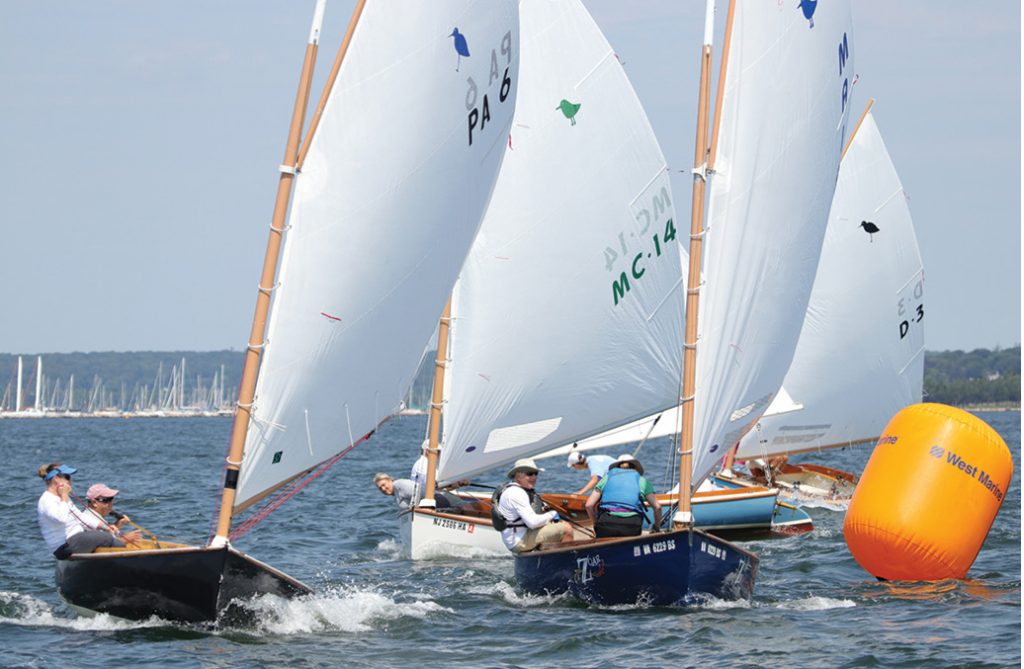Another important factor in any pre-start strategic plan is the current. First you must observe and get an accurate picture of how the current is flowing across the course area. Then you have to figure out how this affects your strategic plan.
Collecting current information
Just as you must gather wind data before the start, you have to collect information about the set (direction) and drift (speed) of the current.
• Before you leave the dock, look at local tide charts or current charts for predictions about current direction and strength. The relative daily tide height will give you a good idea of how strong the current may be that day.
• Don’t rely solely on this type of forecast for your strategy, though, since it won’t cover the peculiarities of your course area. Make sure you talk to local knowledge gurus, and collect your own observations about current in the racing area.
• When you are sailing around before the start, think about two important things: 1) Does the cur- rent set or drift vary across the race course? and 2) Will the current set or drift change between the start of the race and the finish?
• The best place to see current on the race course is near any buoy or boat that is anchored to the bottom. Marks, lobster pot buoys, the committee boat and other anchored boats are all good indicators, so make sure you sail by these (in different parts of the course) during your pre-start preparation time.
• One way to measure current is by placing an object like a sponge in the water near a buoy. Let this sponge drift for 10 minutes and see how far it moves away from the buoy. This will give you a good idea of the current set and drift.
• To gauge current in different parts of the course, look around to see where the appearance of the water and waves might look a little confused or unusual.
• As you collect information
on current, think about the relative importance of this data versus other strategic factors. For example, let’s say you observe a half-knot current flowing across your course. In light air this could have a huge effect, so it should be a strategic priority. In heavy air, however, you might not even notice a half-knot current, so you should focus on other strategic factors.

Unless you have fancy instruments, the only place where you can judge current on the race course is at anchored objects like marks, crab buoys or lobster pots. Therefore, be sure to take a good look at these as you sail around before the start. © Spectrum Photo/Fran Grenon
Strategic principles in current
It’s important to collect accurate info about current because this will likely affect how you sail the race.
• First of all, if the current is the same across the course and it will stay that way during the race, then as far as current is concerned, it doesn’t matter which way you go. In other words, it won’t matter if you sail the upcurrent tack first or last. All boats are on the same “moving rug” and will be affected equally by the current.
• The same principle applies at the starting line. If the current is running from the pin toward the RC boat, the pin is not favored just because it’s farther upcurrent.
• One place on the race course where current often makes a big difference is at marks, including the starting and finishing lines. These are fixed to the bottom so they are not part of the “moving rug.” As a result, the current will skew all your laylines and rhumblines.
• The current may also have a great effect on course geometry. Even if the first mark is set directly into the wind, if you have a cross-current, one tack (the one that is more upcurrent) may actually be a lot longer than the other. So consider this when making your first-leg strategic plan.
• Remember that if the set or drift of the current changes, it will affect not only how you move over the bottom, but it will also change your sailing wind (the vector sum of the true wind plus wind created by current). Strategically, this will make the most difference when the wind is lighter. ■
This article originally appeared in David Dellenbaugh’s Speed & Smarts, The newsletter of how-to tips for racing sailors. If you want to sail faster and smarter, log onto SpeedandSmarts.com.



